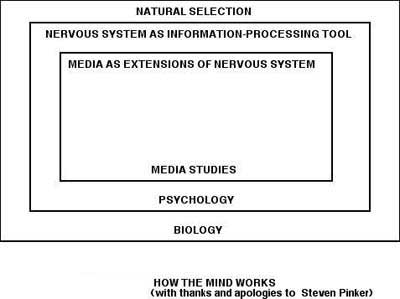Anthropotropism is the principle that technologies work better when they respect the nature of the human body and the human mind. Alternatively, as media evolve they replicate human characteristics, behavior and/or adapt to them. The concept is most commonly associated with media scholar and science-fiction author Paul Levinson and his book, The Soft Edge.
Levinson, and his mentor Marshall McLuhan believe that all media, in time, are reshaped to conform to human physical attributes and cognitive structures, and are thus extensions of the self. Levinson is quoted in The Soft Edge as saying "...media must respect human nature, and satisfy human needs."
The Wallace Paradox
The Wallace Paradox, according to Professor W. Lambert Gardiner, is the inexplicable speed at which human mental function evolved in relation to the observed typical speeds of biological evolution. The paradox suggests there must be another factor influencing the pace of human cognitive development.

Gardiner's take on the bio-media connection
- The recent shifts from a hunter-gatherer society to an agricultural society to an industrial society to an information society have taken place in too short a time to be explained by the theory of evolution. Historical time is too short for the mechanisms of evolution to have much effect. Barbara Parker points out that it takes 500-1,000 generations for a survival-enhancing adaptation to become genetically encoded and we have had only about 100 generations since the birth of Jesus Christ. It is unlikely then that there is much genetic difference between our hunter-gatherer ancestors and you and I.
- Alfred Russel Wallace (1823-1913) had discovered the principle of natural selection at the same time as Darwin. Indeed, he published the same theory in the same issue of the same journal. Most people assumed, as did I, that he does not get as much credit as Darwin, because he did not spend 17 years accumulating empirical evidence for the theory. However, modern evolutionary theorists argue that he had done his homework. The main reason he does not get as much credit is because he subsequently abandoned the theory. He could see no way in which adaptation to a hunter-gatherer society could explain the sophisticated modern mind. How could a species, which evolved by adapting to a hunter-gatherer society, deal with the dramatic shifts to an agricultural society, then to an industrial society, and now to an information society?
- This book suggests that at least part of the answer to this Wallace Paradox is that, during historical time, we have extended our nervous systems by developing tools for storing and transmitting information outside our bodies.4 The story of how we acquired those extrasomatic tools is the history of media. This history of media could thus be considered as an attempt to solve the Wallace Paradox, or, returning to the jigsaw metaphor above, to fill in the third border in the emerging picture of the human mind.
Extensions of the physical self
The Telephone

An old Telephone
Once connected to the wall, users were forced to walk over to the phone when it rang. Later, car phones became available to give people a place to make and receive calls outside of the home or office. And now, phones are highly portable, relying only on their distance from Cell Towers. They are being re-shaped to better adapt to the form of the human face, freeing users to use their hands freely when they talk, as they would if they were speaking with someone in the same room.
The Mouse
In the early days of computers, the only way to navigate through the graphic interface was exclusively done by use of the keyboard. That all changed when researcher Douglas Engelbart of the Standard Research Institute invented The Mouse, a pointing device that could be moved by the user's hand on an X/Y axis. The movement of the mouse corresponds with a pointer on the computer screen to help humans easily navigate through the graphical interface, along with buttons tied to functions or commands, as if the user was manipulating the computer with his/her fingers. The Mouse was a breakthrough in combining hand-eye coordination in computer usage for a natural interactive navigational interface. The Mouse has changed over the years, adding more buttons, removing the ball in favor of optics, becoming more ergonomic, and even becoming wireless for added convenience.
Digital Photography

The rear interface of the Canon EOS 5D
For years, when someone took a photograph, the image was captured onto a piece of film. The image laid emblazoned onto the film until it went through a chemical development process to become a negative. After light shined through the negative onto photo paper, the photo paper passed through a development process. Only after that final development, did the image from the camera finally reveal itself in its true form. This time consuming process plays against the human need of the instantaneous reward of the captured image. This all changed when digital photography allowed the implementation of a way to instantly view the captured images on the cameras interface. This was a substantial upgrade in the way people edit as they take photographs, allowing the individual to immediately determine if the captured image was satisfactory and to their liking. This, along with other aspects of the conveniences of digital photography have put a substantial damper in the use of traditional film photography.
DVRs
Before Digital Video Recorders, or DVRs were invented, the only way to record a television program was on to a VHS tape or DVD. VHS tapes and DVDs had to be bought, allowed a limited amount of storage, and required large amounts of space keeping them around. The creation of the DVR made it possible for users to record multiple television programs and store them on a single hard drive. People no longer have to buy the recordable media or at the store. DVRs allow users to set many different recording options regarding specific programs or channels, including how often to record the program. Some DVRs can even record programs that it thinks the user may enjoy based on the catalog of recordings the user typically makes. This evolution of the recording of television is a great example of how technology and the media have adapted to our own human design. Many people are too busy to watch the television programs when they originally air, leading to the demand of recording devices. With the use of DVRs, users don't even have to be present to record the program. Engineering automation to make things easier for ourselves is an example of the anthropotropic principles taking place.
Examples of Anthropotropism in Media
The News Ticker

The news ticker of Fox News Channel
The News Ticker, also referred to as the crawl, is a line of scrolling text on the bottom of a television broadcast. It debuted on the first ever edition of NBC's Today show on January 14, 1952, and was used sparingly over the years by broadcasters to display headlines, stock prices, weather, and other information to viewers. This changed on September 11, 2001 when terrorist attacks on the United States left Americans panicked and desperate for emergency information and any and all updates regarding the attacks. By that afternoon, every major American news network added crawls to their broadcast. The demand for information following the attacks was so intense that news agencies ran as many as 3 crawls on the bottom of the screen displaying updates. Crawls related to the attacks ran on most 24 hour news channels for around three weeks, but all of the news networks absorbed the ticker into their usual format as viewership had increased as a result of the rapid simultaneous dissemination of information.
Internet Communications
Through out the history of the Internet, the tool used to communicate have improved multiple times. These evolved applications that let us talk to each other improve constantly. Some of the first tools used to communicate over the internet were programming languages. Since not everyone knew computer code and computers were ready to be released on a wide scale, new communication tools were invented. Email allowed people to have personal accounts and be able to send messages to each other. Chat rooms gave people a place to "meet" on the internet. Soon more applications where created to make communication easier for users. Instant Messaging became popular because it allowed users to talk privately with other individuals over the web. Now with latest applications such as iChat for Apple computers, people can video chat with up to four other people at the same time. This has completely allowed people to be personal and face to face with each other while still communicating over the internet. The evolution of internet communications is a great example of how media has evolved to suit our human nature.
External Links
- Part Of Human Brain Functions Like A Digital Computer, According To CU-Boulder Professor press release from the University of Colorado
- Why New Media Matter from Evolutionarymedia.com
- Jeff Han: Unveiling the genius of multi-touch interface design from the Technology, Entertainment, Design (TED) Talks series
- Jeff Hawkins: Brain science is about to fundamentally change computing from the Technology, Entertainment, Design (TED) Talks series
- Ray Kurzweil: How technology's accelerating power will transform us from the Technology, Entertainment, Design (TED) Talks series